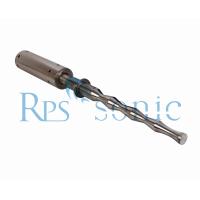20khz 3000w ultrasonic sonochemistry water treatment for medical
extraction
Parameter
| Model | SONO20-1000 | SONO20-2000 | SONO15-3000 | SONO20-3000 |
| Frequency | 20±0.5 KHz | 20±0.5 KHz | 15±0.5 KHz | 20±0.5 KHz |
| Power | 1000 W | 2000 W | 3000 W | 3000 W |
| Voltage | 220/110V | 220/110V | 220/110V | 220/110V |
| Temperature | 300 ℃ | 300 ℃ | 300 ℃ | 300 ℃ |
| Pressure | 35 MPa | 35 MPa | 35 MPa | 35 MPa |
| Intensity of sound | 20 W/cm² | 40 W/cm² | 60 W/cm² | 60 W/cm² |
| Max Capacity | 10 L/Min | 15 L/Min | 20 L/Min | 20 L/Min |
| Tip Head Material | Titanium Alloy | Titanium Alloy | Titanium Alloy | Titanium Alloy |
Introduction:
Ultrasonic Sonochemistry is the cross-penetration of acoustics and physical chemistry, and
it is also a branch of physical chemistry. Ultrasonic can
accelerate conventional chemical reactions, accelerate the
decomposition and synthesis of substances in organic solvents, and
strengthen chemical units (ultrasonic cleaning, ultrasonic extraction, ultrasonic crystallization, ultrasonic emulsification, ultrasonic flocculation, ultrasonic adsorption and ultrasonic membrane separation, etc.). These applications are called sonochemistry. Sonochemical
technology is an emerging, multidisciplinary and fringe science
developed in the 20th century.
The cavitation effect of ultrasonic energy Irradiate the solution
with a certain sound intensity. When the sound intensity increases
to 0.5 ~ 0.7 W / cm *, if you put a hydrophone in the solution, you
can hear the strong noise in the solution. . This noise occurs with
the phase of the sound field and occurs once in one or more cycles.
It has been found that this noise essentially bends when the sound
field is in the expanding phase, and the trace gas dissolved in the
solution accumulates into small bubbles (also known as cavitation
nuclei). After the sound field becomes a compression phase, the
radius meets- Conditioned gas pools are rapidly compressed and
inward condensation occurs. In this way, the liquid wall around the
bubble produces a strong paddle sound when it shrinks rapidly. This
process is usually extremely momentary and only occurs between a
few nanoseconds and a few microseconds. For the gas in the bubble,
the temperature rises sharply after being compressed. This
temperature is usually astonishingly high, reaching a maximum of
more than 10,000 degrees Celsius, and at a few thousand degrees
when it is low. This physical process is called cavitation effect,
and the accompanying noise is called cavitation noise. This
temperature is related to the green strength, the initial radius of
the bubble, the radius at which the compression ends, and the
specific heat capacity of the gas. Therefore, as the dissolved gas
in the solution is different, the temperature at which the
cavitation region terminates after cavitation occurs is not the
same, and the volume of the solution in which the rare gas is
dissolved often has a higher cavitation termination temperature.
The local high temperature in the solution caused by the cavitation
effect is the determinant of the chemical reaction.
Cavitation effect and sonochemical reaction Because the temperature
of the cavitation region is extremely quotient, this region is
generally called a hot spot ", which is the local quotient
temperature point in the solution. The high temperature of the hot
spot causes the interface between bubbles and liquid to be several
hundred nanometers thick In the city being poured, the liquid
molecules are cracked into free radicals. Due to the rapid
contraction of the liquid wall when cavitation occurs, these: free
radicals are projected into the solution at high speed at the same
time as these are generated, and these highly talkative free
radicals will be mixed with ficus Free radical reactions of
molecules in the liquid, which trigger a series of chemical
reactions
Application:
• Cell disrupter (extraction of plant substances, disinfecting,
enzyme deactivation)
• Therapeutic ultrasound, i.e. induction of thermolysis in tissues
(cancer treatment)
• Decrease of reaction time and/or increase of yield
• Use of less forcing conditions e.g. lower reaction temperature
• Possible switching of reaction pathway
• Use of less or avoidance of phase transfer catalysts
• Degassing forces reactions with gaseous products
• Use of crude or technical reagents
• Activation of metals and solids
• Reduction of any induction period
• Enhancement of the reactivity of reagents or catalysts
• Generation of useful reactive species

Before ultrasonic treatment

After ultrasonic treatment











